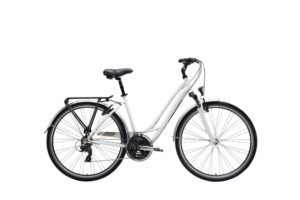Choosing the right bike can be daunting, especially if you’re new to cycling or last rode a while ago. With so many different types of bikes on the market, it cannot be easy to know where to begin. Two popular options are comfort bikes and mountain bikes. While they may look similar at first glance, they are designed for different purposes. Comfort bikes are ideal for leisurely rides on smooth surfaces, while mountain bikes are built to tackle rugged off-road terrain. So, if you’re looking for a new bike, which one should you choose?
In this post, we’ll compare comfort and mountain bikes to help you determine which is right for you based on your needs, preferences, and riding style.
Difference Between Comfort Bike and Mountain Bike:
| Feature | Comfort Bike | Mountain Bike |
| Purpose | Leisurely rides on paved/smooth surfaces | Off-road riding on rugged terrain |
| Riding position | Upright, relaxed | More aggressive, leaning forward |
| Suspension | Front suspension, some with seat post suspension | Front and/or rear suspension |
| Tires | Narrower, smoother, designed for pavement | Wider, knobby, designed for off-road terrain |
| Gears | Fewer gears, geared towards ease of use | Sturdy, durable, and designed for rugged terrain |
| Frame | Lightweight, simple | Disc brakes, are more powerful and responsive |
| Brakes | Rim brakes, adequate for casual riding | Disc brakes, more powerful and responsive |
| Weight | Typically, lighter | Typically, heavier |
| Terrain Limitations | Suitable for smooth surfaces | Suitable for rough, off-road terrain |
What Is Comfort Bike?

A comfortable bike is designed for casual, leisurely riding on paved or smooth surfaces. It typically features a wide, padded seat, an upright handlebar position, and suspension to absorb bumps and vibrations. Comfort bikes prioritize comfort and ease of use over speed and performance, making them popular for recreational riders, commuters, and those looking for a low-impact way to exercise. They are often equipped with fenders, lights, and racks to enhance their practicality and versatility.
Key Features:
Some key features of comfort bikes include:
- Upright riding position: Comfort bikes have a relaxed, good riding position that is easier on the back, neck, and shoulders. This is achieved through a raised handlebar and a shorter top tube.
- Wide, padded saddle: A comfortable saddle is essential for any bike, and comfort bikes typically have wider, more cushioned saddles than other types of bikes. This helps distribute weight more evenly and reduces pressure on sensitive areas.
- Suspension: Many comfort bikes have front suspension forks or seat post suspension to absorb bumps and vibrations from the road, further enhancing comfort.
- Wide tires: Comfort bikes usually have wider tires than road bikes, which provides better stability and grip on paved surfaces.
- Easy-to-use gears: Comfort bikes typically have a smaller range of gears than other bikes, but they are geared towards ease of use and low effort. This makes them ideal for riders who want to avoid sweating or needing help shifting gears.
- Suspension: Mountain bikes have suspension systems to absorb the shocks and bumps of off-road riding. These can be front suspension (forks) or full suspension (both front and rear).
- Wide tires with knobby treads: The tires on a mountain bike are wider than those on a road bike, and they have knobby treads for better traction on loose or uneven terrain.
- Robust and durable frame: Mountain bikes have sturdy frames made of aluminum or carbon fiber, which can withstand the rigors of off-road riding.
- Disc brakes: Mountain bikes often have disc brakes, which provide more stopping power than traditional rim brakes, especially in wet or muddy conditions.
- Wide range of gears: Mountain bikes have a wide range of gears, which makes it easier to pedal up steep hills or through rough terrain.
- Dropper seat post: Some mountain bikes come with a dropper seat post, allowing the rider to adjust the saddle height on the fly, making it easier to transition between uphill and downhill riding.
- A comfort bike may be the better choice if you prefer leisurely rides on smooth surfaces like pavement or bike paths.
- However, a mountain bike is a way to go if you plan to ride off-road on rugged terrain. Mountain bikes offer a more aggressive riding position, wider tires with knobby treads for better grip, and suspension to absorb shocks on rough terrain.
What Is Mountain Bike?
Mountain bikes are designed for off-road riding on rugged terrains such as mountains, forests, and trails. Mountain bikes are built with suspension systems, wide tires with knobby treads for better traction, and sturdy frames to handle rough terrain. They also often have many gears to help riders tackle steep hills and other challenges. Mountain bikes come in a variety of styles, including hardtail (with only front suspension), full-suspension (with front and rear suspension), and fat bikes (with extra-wide tires for added stability).
Key Features:
Here are some key features of mountain bikes:
Detailed Comparison Of Comfort Bike VS. Mountain Bike
Design and Construction – The Backbone of the Bike
Comfort bikes are designed to focus on comfort and ease of use, typically featuring an upright riding position, wider and more padded seats, and shock-absorbing forks. The frame design is usually more relaxed, with a lower top tube, making it easier to get on and off the bike. Comfort bikes typically have fewer gears than mountain bikes, as they are designed for leisurely rides on smooth surfaces and are usually equipped with simple linear-pull brakes.
While mountain bikes are built for performance and handling rough terrain, they have a more aggressive frame design, with suspension systems that can handle bumps and jumps, wider and knobbier tires for better traction, and more powerful disc brakes. They typically have a more significant number of gears, allowing for a wider range of speeds, and are designed for a more forward-leaning riding position to maximize power and control.
Riding Style – The Key to Choosing the Right Bike
Mountain bikes are designed for more aggressive riding on rough terrain. They have a more aggressive frame geometry, with features like suspension systems, wider tires, and disc brakes that provide better traction and stability on uneven trails. Mountain bikes also have a wider gear range, which allows for more incredible speed and performance on rough terrain.
Comfort bikes are designed for leisurely rides on smooth surfaces, with a more relaxed riding position and features that prioritize comfort. They typically have wider seats, shock-absorbing forks, and upright handlebars, making them ideal for casual riders who want a comfortable, easy-to-ride bike.
Performance and Speed – Pushing the Limits of Bike Capability

Mountain bikes are designed for speed and performance on rough terrain. They have features such as multiple gears, lightweight frames, and suspension systems that allow for efficient pedaling and quick maneuvering. With their larger wheel size and narrower tires, mountain bikes are built for speed and agility.
Comfort bikes, on the other hand, are not designed for high-speed performance. They prioritize rider comfort over speed and efficiency, with features like upright handlebars, shock-absorbing seats, and wider tires. While comfort bikes may be slower than mountain bikes, they are great for leisurely rides on smooth surfaces and provide a more relaxed riding experience.
Terrain and Conditions – The Ultimate Test for Bikes
Comfort bikes are designed for leisurely riding on paved or well-maintained surfaces. They typically feature a relaxed, upright riding position, a padded saddle, and wide tires for stability and comfort. Comfort bikes also often include features like suspension forks and seat posts to absorb bumps and shocks and easy-to-use gear systems for smooth and effortless shifting.
Mountain bikes, on the other hand, are built to handle rough terrain and challenging conditions. They typically feature a more aggressive riding position, with a lower center of gravity for better control and maneuverability. Mountain bikes also feature wider, knobby tires for improved traction on loose or uneven surfaces, sturdy frames, and suspension systems to absorb impact and provide a smooth ride.
Suspension and Brakes – The Critical Elements for Safety and Comfort
Bike suspension and brakes play a critical role in the performance and safety of both comfort and mountain bikes. Mountain bikes are designed for more challenging terrain and typically have front and rear suspension systems to absorb shock and maintain traction. They also often have hydraulic disc brakes, which provide more robust and reliable braking performance in the variable and steep terrain of mountain biking.
Comfort bikes typically have a front suspension fork that helps absorb shocks from bumps and rough terrain, providing a smoother ride. They also usually have a rim or essential disc brakes, which offer adequate stopping power for leisurely riding.
Gear Range – The Key to Tackling Any Terrain
Comfort bikes typically have a narrower gear range compared to mountain bikes. They are designed for leisurely rides on relatively flat terrain, so they don’t need as many gears to tackle steep hills or technical trails. A typical comfort bike may have a gear range of 21-24 speeds, with a triple front chainring and a seven or eight-speed rear cassette.
In contrast, mountain bikes are built to handle more challenging terrain and usually have a wider gear range. A typical mountain bike may have a gear range of 24-30 speeds, with a triple or double front chainring and a nine or ten-speed rear cassette. This allows riders to easily tackle steep hills and technical trails while also providing plenty of options for maintaining speed on flatter sections of the trail.
Wheel Size – Balancing Speed, Control, and Stability
Comfort bikes typically have more extensive, wider wheels than mountain bikes. The most common wheel size for comfort bikes is 26 inches, although some models may have 27.5-inch or 29-inch wheels. The larger size provides stability and a smoother ride on pavement or light off-road terrain.
Mountain bikes typically have smaller wheels for better maneuverability and control on rough terrain. The most common wheel size for mountain bikes is 27.5 inches, although 29-inch wheels are becoming more popular. Some mountain bikes also use 26-inch wheels, particularly in smaller sizes.
Weight – The Impact of Bike Weight on Performance and Endurance
In terms of weight, comfort bikes are typically lighter than mountain bikes. This is because comfort bikes have a simpler design and fewer components than mountain bikes, which often have more durable frames and suspension systems. The weight of a comfort bike can vary depending on the specific model and materials used, but they generally range from 25 to 35 pounds. Mountain bikes, on the other hand, can weigh anywhere from 30 to 40 pounds or more, depending on the level of suspension and the materials used in the frame and components.
Finally, Comfort Bike Or Mountain Bike: Which Is Perfect For You?
Choosing between a comfort bike and a mountain bike ultimately comes down to your riding style, preferences, and the terrain you plan to ride on.
Whichever you choose, test-ride different models and find the most comfortable that suits your needs.
FAQs
What is the main difference between a comfort bike and a mountain bike?
The main difference between a comfort bike and a mountain bike is the type of terrain they are designed for. Comfort bikes are built for leisurely rides on smooth surfaces such as pavement or bike paths, while mountain bikes are designed for off-road riding on rugged terrain.
Can I use a comfort bike on off-road trails?
While comfort bikes can handle some light off-road terrain, they are not designed for rugged trails and may not have the necessary features such as suspension or wide tires with knobby treads to handle rough terrain.
Can I use a mountain bike on paved surfaces?
Yes, mountain bikes can be used on paved surfaces, but they may not be as efficient or comfortable as a bike designed specifically for paved surfaces like a comfort bike. A mountain bike’s wide, knobby tires can cause more rolling resistance on smooth surfaces.
Which bike is better for a beginner rider?
It depends on the riding the beginner rider plans to do. A comfort bike may be a better choice if they plan to ride on smooth surfaces like pavement or bike paths. A mountain bike would be more suitable if they plan to ride off-road on rugged terrain.
Which bike is more comfortable to ride?
Comfort bikes are designed with a more upright riding position and typically have broader, more cushioned seats, making them more comfortable for leisurely rides on smooth surfaces. Mountain bikes are designed for a more aggressive riding position and may be less comfortable for longer, leisurely rides. However, a well-fitted mountain bike with proper suspension can also provide a comfortable ride on rough terrain.

I am Ryan Ford, a mountain biking enthusiast who loves to explore the outdoors. I also like to go on adventures with friends and anything else that involves being outside. I love my bike because it gets me out of the house and gives me an opportunity to enjoy nature.

